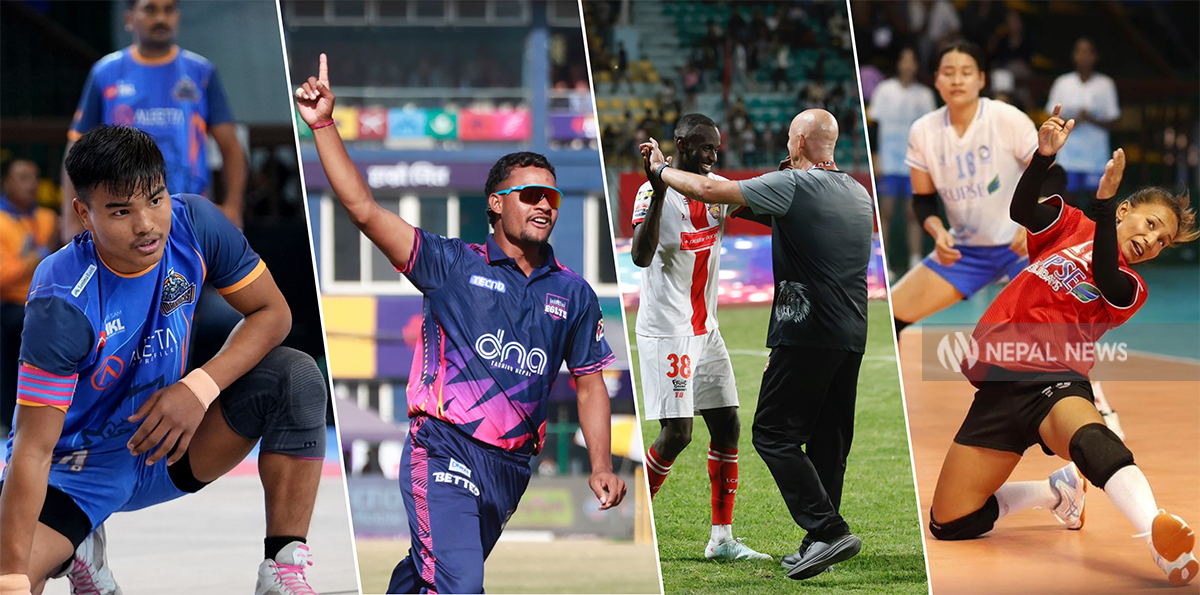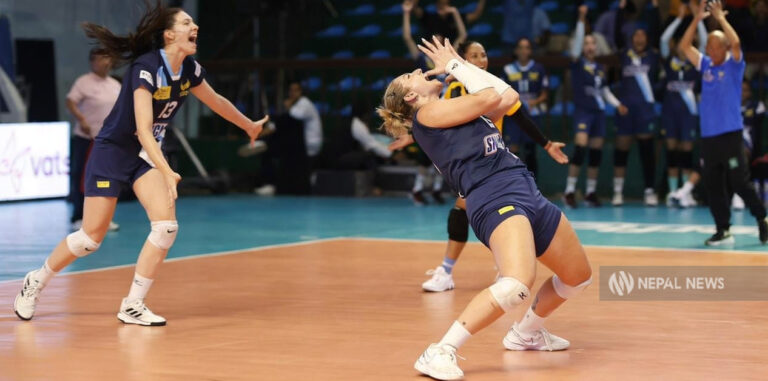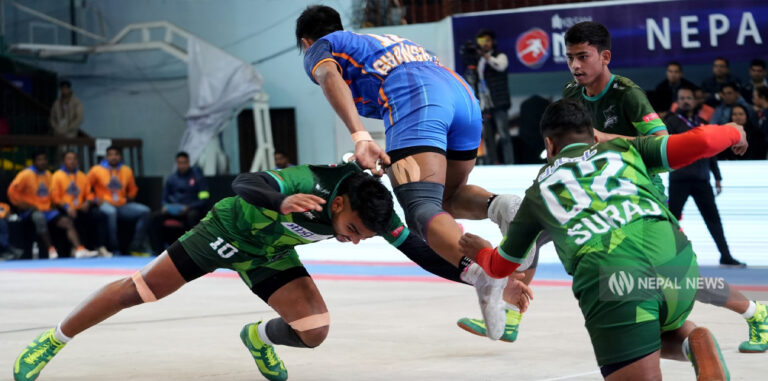
Teams struggle as revenue and expenses fail to balance

KATHMANDU: Karan KC, a medium-pace bowler for the Nepali national cricket team, has been playing for the national side for over a decade. During this time, he has played 300 matches at home and abroad. He also has a large fan base. However, debt never left his side. He also played while being associated with the departmental team, Nepal Police Club. At present, he has managed to free himself from some debt. That opportunity came through the first edition of the Nepal Premier League (NPL). Kathmandu Gurkhas contracted him for Rs 2 million in that league.
The situation was similar for national team opening batter Aasif Sheikh. He too was contracted by Janakpur Royals in the first edition of the NPL. With the money he earned from the NPL, he managed to cover his wedding expenses.
The Cricket Association of Nepal has long been providing salaries and facilities to its players. Even so, players like Karan and Aasif have struggled to manage their livelihoods with ease.
If this is the condition of cricketers, who are considered relatively better off, then what must be the condition of players from other sports? It is something everyone can guess.
Nepal is currently grappling with an economic downturn. The government has been weakened as it has failed to collect enough revenue. Amid such adverse circumstances, however, some rays of hope have begun to shine in Nepali sports. That opportunity has been created by franchise leagues.
Recently, not only cricket and football but also volleyball and kabaddi have hosted franchise leagues. The crowds cheering with drums and waving franchise flags in support of their teams have electrified the Nepali sporting scene.
Captain Ghanashyam Roka Magar, who played for Haryana Steelers in India’s Pro-Kabaddi League for two seasons, has yet to receive any salary or benefits from the All Nepal Kabaddi Association. While playing in India’s professional league, he used to earn 1.3 million Indian rupees (about Rs 2.08 million) per season. Because of that, his household financial situation is somewhat secure.
The condition of other players, however, does not look as good. In such a situation, the Nepal Kabaddi League (NKL) was held in January 2025. This provided some relief for players. Ghanashyam, as a marquee player for Kathmandu Mavericks in the NKL, received Rs 100,000 for the season. Other players like him also earned decent sums by participating in the league.
“Our team mostly has players who only play domestic tournaments. Those who are in departmental teams are in a comfortable position. But for those not associated with departmental teams, this has created an environment to earn some income,” says Ghanshyam, the marquee player and captain of the Mavericks.
Franchise leagues have not been in Nepal for very long. The Dhangadhi Cricket Academy first sounded the bugle of franchise leagues in 2017 by launching the Dhangadhi Premier League (DPL).
With its success, EPL Pvt. Ltd. introduced the Everest Premier League (EPL), and Nepal Sports and Event Management (NSEM) ventured into football. Amid disputes, the EPL has not really been visible. However, the recently concluded Nepal Super League (NSL) at Dasharath Stadium has created a new buzz in football.

Players of NSL club Lalitpur FC celebrating after a goal.
Karan KC, who has repaid some of his debt by playing in the NPL, says, “I had taken a loan to build a house. After three or four editions of the league, I should be able to clear it.”
If we leave aside 5–6 sports associations in Nepal, the situation of all the others is weak. Poor managerial capacity, lack of planning, and inability to set goals have left these sports associations in a pitiable state.
Despite this, cricket, football, volleyball, and kabaddi have entered the field with new plans. Therefore, compared to other sports, players from these associations seem somewhat fortunate.
The Cricket Association of Nepal (CAN) organized the Nepal Premier League (NPL) for the first time 10 months ago with its own investment. Foreign players, foreign broadcasting channels, and investments running into millions—not only was it a sporting event, it also became a source of entertainment, national pride, and a means to connect ordinary citizens with sports.
The third edition of the Nepal Super League (NSL), held at Dasharath Stadium in Tripureshwor, also injected life into the otherwise sluggish Nepali football scene. In the covered hall next to the stadium, the Everest Women’s Volleyball League (EWVL) took place last August, and the Nepal Kabaddi League (NKL) was held in January 2025. EWVL Season 2 is set to begin in Pokhara on September 5, while preparations are underway to launch the men’s Nepal Volleyball League (NVL).
Players’ enthusiasm and earnings
Like Karan, seven franchises in the NPL provided similar amounts to seven other cricketers. Besides them, 11 players were sold for a maximum of Rs 1.5 million each. Similarly, eight franchise companies spent Rs 59,250,000 to bring 80 players who were part of the auction into their teams.
Janakpur Royals’ marquee player Aasif Sheikh says, “The money I earned from the league was enough for my wedding.” He got married immediately after the conclusion of the NPL.
Cricket Association of Nepal (CAN) raised Rs 168,893,231 from the sale of franchise teams. It received Rs 200 million through a five-year sponsorship deal with Siddhartha Bank. CAN claims to have earned Rs 59.2 million by selling “commercial rights” to Brand Logic Company. Additionally, CAN says it earned substantial money from placing sponsor boards in the stadium (20% share) and from ticket sales. Similarly, by bringing in a “surrogate” company for an online gambling app—which is banned in Nepal—as a sponsor, CAN also raised funds.
From the NPL, CAN’s total revenue was Rs 276,964,818. Out of this, the net profit was Rs 24,650,789.

Janakpur Bolts players after winning the NPL by defeating Sudurpaschim Royals in the final.
It is not just cricket; Infinity Dreams, which organizes the Everest Women’s Volleyball League (EWVL), signed a seven-year agreement with the Nepal Volleyball Association worth Rs 250 million.
Similarly, Astronics Management, the organizer of the Nepal Kabaddi League (NKL), signed a ten-year agreement with the All Nepal Kabaddi Association. According to the agreement, Astronics Management will pay the association Rs 1.5 million annually, and an additional Rs 1.5 million whenever the team participates in international competitions. Under the contract, the management company is allowed to raise Rs 3.5 million from six franchises.
The Kabaddi and Volleyball Associations typically spend between Rs 1.5–1.8 million to form a team for franchise leagues. The associations claim that players earn good income from this. Players participating in the NKL received salaries according to their category: Rs 50,000, Rs 60,000, and Rs 75,000. Marquee players were paid Rs 100,000, and foreign players received $1,000 each.
In football, these amounts are comparatively large. For one team, the total expenditure is around Rs 12.5 million. This does not include players’ accommodation, food, transportation, or kits.
The Nepal Super League (NSL) signed an agreement to pay the All Nepal Football Association (ANFA) Rs 170 million over eight years. So far, three editions of the league have been completed.
The main sources of revenue for all these franchise leagues are sponsors and ticket sales. Organizers also earn income by selling temporary parapets, lounges, VIP access, and broadcasting rights. These competitions provide financial benefits not only to players but also to the technical staff.
“Currently, it appears that a franchise team can potentially earn Rs 5–6 million,” says CAN secretary Paras Khadka.
Challenges in balancing finances
While Khadka makes this claim, team owners in the NPL assert that forming a team costs Rs 60–80 million. This puts teams under pressure to balance expenditures. Moreover, weak financial transparency within the associations creates uncertainty for investors.

Karnali Yashvis foreign players after winning Everest Women’s Volleyball League.
Meghraj KC, technical manager of the NSL franchise Kathmandu Rayzrs and head coach of Tribhuvan Army Club, says, “In football too, forming a team costs Rs 17.5–22.5 million. This is a positive aspect for football. But financial balance is not being maintained. This increases uncertainty for the future, so caution is necessary in time.” However, revenue collection remains low. According to club operations, they earned only Rs 600,000–800,000 in the second edition.
Apart from cricket and football, organizers claim that Kabaddi and volleyball also cost Rs 1.5–1.7 million. Amit Begani, chairman of NKL organizer Astronics Management, shares his experience: “I was attracted by the craze of the NPL and NSL. But when I saw the low returns compared to the investment, I couldn’t sleep at night.”
Infinity Dreams Pvt. Ltd. has organized a women’s franchise league in Nepal for the second time. Queens Event Management Pvt. Ltd. had previously organized Nepal’s first women’s franchise T20 cricket league, the Women’s Champions League (WCL), in 2019. CAN secretary Paras Khadka, Nepali national team assistant coach Gyanendra Malla, and CAN spokesperson Chhumbi Lama, among others, organized that franchise league. However, that league could not progress beyond its first edition.
Therefore, the future of women’s franchise leagues in Nepal does not look very promising. Being private-sector ventures, the organizers of the EWVL have not disclosed how much revenue they earn. Snevy Chaulagain, CEO of Infinity Dreams Pvt. Ltd., says that holding a women’s franchise league in itself is a positive development.

Biratnagar Bandits players tackle Kathmandu Mavericks captain Ghanshyam Roka Magar.
“Organizing the first edition for women is a sign of success. A significant investment was made. It’s difficult to say exactly how much was spent. There were six teams and the investment in the league itself. It may not be appropriate to speak without everyone’s approval,” she says.
From the organizers’ perspective, hosting an international-level competition in the National Sports Council’s covered hall requires substantial investment. High-quality production is demanded by sports audiences. Organizing this in the covered hall is a challenging task. There are no other alternatives in Kathmandu.
She adds that sustaining the league is very challenging. “Volleyball is a national sport. There is also great potential for women’s sports. Players are happy. The associations and the council are positive. We are confident that if we continue, supporters will back us. That is our satisfaction,” she says.